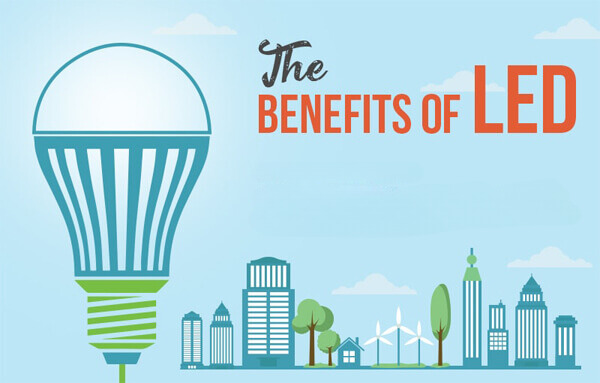

LED lights, or Light Emitting Diodes, are a revolutionary lighting technology that has gained immense popularity recently. These energy-efficient and versatile light sources have found applications in various settings, from residential homes to commercial spaces and even outdoors.
In this blog, we will explore what LED lights are, the benefits of LED lights, differences from regular lights, and the different types of LED lights available.
What are LED Lights?
LED lights are semiconductor devices that emit light when an electric current passes through them. Unlike traditional incandescent bulbs that rely on heating a filament to produce light, LEDs work by electroluminescence, converting electricity directly into light.
LEDs were first developed in the early 1960s, and since then, they have undergone significant advancements, making them one of the most popular and widely used lighting solutions today.
Where can LED Lights be Used?
The versatility of LED lights allows them to be used in numerous applications. Here are where LED lights can be used:
- Residential lighting: LED bulbs are ideal for everyday use in homes, as they provide bright illumination while consuming significantly less energy compared to incandescent bulbs. They are available in various colour temperatures to suit different preferences.
- Commercial lighting: LED lights are extensively used in offices, retail stores, and industrial settings due to their energy efficiency and long lifespan, reducing maintenance costs.
- Outdoor lighting: LED technology has revolutionized outdoor lighting, including streetlights, floodlights, and landscape lighting, providing better visibility, improved safety, and reduced energy consumption.
- Automotive lighting: LEDs are commonly used in vehicles for headlights, taillights, and indicators due to their durability and energy efficiency.
What are the Benefits of LED Lights?
LED lights offer several benefits compared to traditional lighting technologies. Here are the key benefits of LED lights:
- Energy Efficiency: LED lights are highly energy-efficient, converting nearly all the energy they consume into light. This results in significant energy savings and lower electricity bills.
- Long Lifespan: LED lights have an impressive lifespan, typically lasting 25 times longer than incandescent bulbs and several times longer than compact fluorescent lamps (CFLs). This extended lifespan reduces the frequency of replacements and minimizes waste.
- Eco-Friendly: LED lights do not contain hazardous materials like mercury, which is commonly found in CFLs. As a result, LED lights are more environmentally friendly and easier to dispose of responsibly.
- Instantaneous Lighting: Unlike CFLs, which may take some time to reach full brightness, LED lights illuminate instantly, providing immediate illumination.
- Durability: LED lights are durable and can withstand shock, vibration, and extreme temperature variations, making them suitable for rugged environments and outdoor use.
- Directional Lighting: LEDs emit light in specific directions, allowing for better light distribution and reduced light wastage compared to traditional bulbs.
- Dimmable Options: Many LED lights are dimmable, giving users greater control over the intensity of the light to create the desired ambiance.
What is the Difference Between LED Lights and Regular Lights?
There is a significant difference between LED and regular lights. LED and regular lights represent two distinct lighting technologies that have revolutionized the way we illuminate our surroundings.
Here are some key differences between LED lights and regular lights:
| Parameters | LED Lights | Regular Lights |
| Energy Efficiency | Highly energy-efficient | Less energy-efficient |
| Lifespan | Long lifespan | Shorter lifespan |
| Environmental Impact | Eco-friendly | May contain hazardous materials |
| Warm-up Time | Instantaneous illumination | Some require warm-up time |
| Heat Emission | Low heat emission | High heat emission |
| Light Direction | Directional lighting | Omni-directional lighting |
| Dimmable Options | Many options are dimmable | Limited dimmable options |
What are the Different Types of LED Lights?
LED lights have transcended the limitations of traditional lighting. There are various types of LED lights available in the market, each designed to cater to distinct purposes and enhance our lighting experiences.
- LED Bulbs: These are direct replacements for traditional incandescent bulbs and come in various shapes, sizes, and colour temperatures.

- LED Tubes: Designed to replace fluorescent tubes, LED tubes offer better energy efficiency and last longer.

- LED Strips: These flexible strips are used for accent lighting and decorative purposes.

- LED Floodlights: Ideal for outdoor lighting, LED floodlights provide powerful illumination over large areas.

- LED Spotlights: These focused lights are commonly used for highlighting specific objects or areas.

- LED Panel Lights: Flat and slim, these lights are used in commercial spaces for uniform illumination.

LED lights have revolutionized the lighting industry with their energy efficiency, longevity, and various applications. They offer numerous benefits over regular lights, making them the preferred choice. With the diverse range of LED lights available, consumers can enjoy efficient, eco-friendly, and versatile lighting solutions for a brighter and greener future.
As technology continues to advance, LED lights will likely play an even more significant role in shaping the future of lighting.
